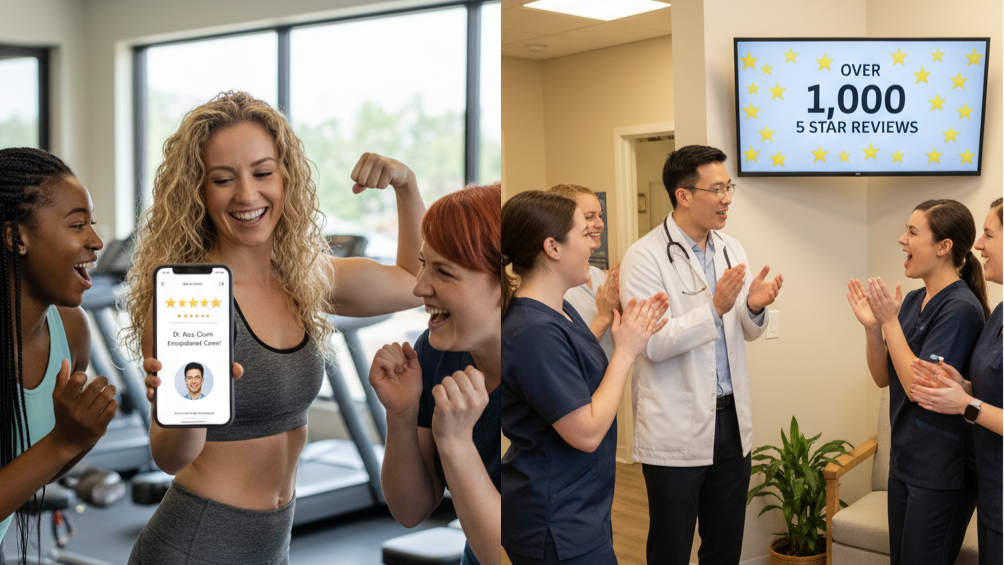Reputation Management in Dolphin Management with Curogram
💡 Reputation Management in Dolphin Management empowers orthodontic and oral surgery practices. These clinics can grow through automated, compliant,...
8 min read
Gregory Vic Dela Cruz : Nov 26, 2025 8:00:00 AM

Support patient satisfaction with simple, clear messages.
Reduce manual follow up workload for your front desk.
Identify trends in patient experience.
Reach patients at the right time for better response rates.
Connect feedback to internal improvement efforts.
The system sends the right request at the best chance. With Curogram, your team can focus on care while feedback arrives in the background.
You probably hear from patients every day, but not in a way that gives you reliable feedback. Some people say thank you. Others mention concerns in passing. A few leave online reviews, but those reviews rarely reflect the full picture.
At the same time, you want your staff to focus on care. They do not have extra time to call patients and ask for reviews. They already juggle phones, check-ins, room turnover, and paperwork. Manually managing patient satisfaction workflows can feel impossible during busy hours. Without structure, reviews come in slowly and inconsistently.
Allscripts review request workflows can help you change this pattern. These workflows allow you to send automated rating requests Allscripts after visits. Patients receive a short, friendly message asking about their experience. Your team does not have to remember each step. The system sends the message at the right time based on the appointment details in Allscripts PM.
In this article, we explore the problems that come with unstructured review processes. Want to learn how automated messaging works inside Allscripts PM? Keep reading. The goal is to help you build a clearer, calmer, and more effective approach to gathering reviews.
In our complete guide to reputation management for Allscripts clinics, we discussed how hard it can be to collect reviews. When you do not have a structured process for collecting reviews, you end up guessing how patients feel. Some people leave public feedback only when they are upset. Others never share their thoughts at all. You miss opportunities to learn from everyday moments that could improve care.
Without a system, reviews come in randomly. You might get several in one week and none the next. Positive experiences are often silent, while negative ones show up online. You cannot rely on these patterns to understand your patient population. This makes planning improvements harder than it needs to be.
Some clinics try to solve the problem by asking staff to call patients or hand out cards. This can help, but it also adds pressure. Your team may forget during busy moments or feel unsure about the best way to ask. They already have long lists of responsibilities. Adding one more step makes the day feel even heavier.
Many patients want to share feedback but forget once they leave. They get back to work, drive home, or take care of family. Even patients with strong opinions rarely take extra steps unless prompted. Without automated reminders, you miss helpful insights simply because life gets busy.
When reviews do not follow a consistent process, the data loses reliability. You cannot compare one month to the next if the sample size changes constantly. You cannot see patterns for different providers or visit types. Without dependable data, it becomes harder to make decisions about workflow improvements.
Patients often notice things staff cannot see. They may experience long waits, unclear instructions, or confusion at checkout. They may feel anxious about a certain process. Without structured Allscripts review request workflows, this information never reaches you in a reliable way.
When patients feel invited to share their thoughts, it builds trust. It shows that their experience matters. Without a pathway for feedback, patients may feel disconnected from your clinic. They may think no one is listening or that their input will not make a difference.
If you run multiple locations, review patterns can vary dramatically. One clinic may have many reviews, while another has very few. This can create an unbalanced online presence. It may give patients the wrong impression about your overall quality. A structured workflow brings more balance across sites.
Automated review requests Allscripts rely on your existing appointment data. The system knows which patient was seen, when the visit occurred, and which provider delivered care. It uses this information to send a rating request that fits naturally into your patient satisfaction workflows.
The workflow starts with the visit itself. Once the appointment status is marked as completed in Allscripts PM, the system knows the visit has finished. This completed status can trigger the review request. You do not have to enter extra information or click additional buttons. Everything moves forward automatically.
Timing matters in patient communication. If you wait too long after a visit, the experience fades from memory. If you send a message too early, the patient may not be ready to respond. Automated review requests Allscripts follow timing rules that match your workflow. The message goes out shortly after the visit when thoughts are fresh.
The messages patients receive are designed to be simple. A short greeting and a link make it easy to respond. Patients do not need to log into portals. They do not need to remember passwords. The process respects their time and attention.
When the system sends review requests, your staff can monitor activity from a clear dashboard. They can see which messages were delivered. They can view high level trends. They do not need to check manually or track paper lists. This visibility helps teams understand the flow of patient feedback.
Allscripts PM stores information for every visit. Automated review processes can use this data to organize feedback by provider or location. You can see how different clinics compare. You can identify strengths and areas that need attention. This helps you plan improvements more confidently.
Some clinics already have internal improvement programs. Automated review requests Allscripts fit into those efforts without replacing them. You can combine automated messages with staff led follow ups. You can use the data to support training or workflow redesign. The tool becomes part of a broader culture of patient-centered care

When you use structured Allscripts review request workflows, you create a smoother path for both patients and staff. You reduce uncertainty. You increase visibility. You improve how people feel about your clinic. These benefits build over time and support your long term goals.
Automated requests help you gather consistent feedback across days and weeks. You no longer rely on chance. This gives you a clearer view of patient experience. You can use this information to guide your decisions.
Patients respond more often when requests come at the right time. Automated timing helps support this. Clear, simple messages reduce friction. People feel comfortable sharing their thoughts.
Your team does not need to call or remind patients. Automation handles these routine tasks. Staff can spend their energy helping people in person. This makes the day feel more manageable.
Consistent feedback helps you understand how patients see your clinic. You can identify trends instead of reacting to single comments. This helps you improve your online presence. It also supports long term reputation growth.
Automated review requests Allscripts ensure each clinic gets similar opportunities for feedback. You avoid uneven review patterns. You support fairness across providers. This helps patients see a complete picture of your organization.
Reviews often reveal needs that were not obvious. People may mention wait times, directions, or communication gaps. Automated workflows bring these insights to the surface. You gain information that supports meaningful improvement.
Structured feedback makes it easier to spot concerns. You can address patterns before they become larger problems. This protects patient trust. It also helps support smoother operations.
Many clinics run internal projects focused on wait times, access, or patient flow. Review data offers real information to support these efforts. Automated systems make the data more dependable. This helps staff see that their work makes a difference.
Providers often want to know how patients feel. Automated reviews give them a clear view. They can see trends without scrolling through scattered comments. This helps them reflect on their approach and celebrate strengths.
When staff are not chasing feedback manually, the day feels quieter. People have more mental space for communication and care. This can reduce stress. It also helps teams stay connected to their purpose.
Patients appreciate being asked about their experience. It shows that their voice matters. Automated reminders make this invitation consistent. Patients feel more connected to your clinic.
Automated prompts feel neutral. Patients do not feel pressured. They can share open and honest thoughts. This helps you understand their true experience.
Without structure, some patient groups respond more than others. Automation helps even out participation. You get a more inclusive sample of voices. This supports fairness in improvement decisions.
Manual tracking leaves room for gaps. Automated data reduces those risks. You get a clearer picture over time. This clarity helps you plan next steps with confidence.
Automated review requests Allscripts create consistent information that grows month by month. This becomes a long term asset. You can look back at patterns and see progress. The information helps guide your future goals.
Together, these benefits help build an environment where patients feel heard and staff feel supported. Automated workflows do not replace human care. They strengthen it with clarity, consistency, and reliable feedback.
Consider a multi location primary care group that wanted to understand patient experience more clearly. They were relying on occasional online comments and informal conversations. Staff members tried asking for reviews during checkout, but they often forgot during busy moments. Providers wanted better insight, but there was not enough consistent data to guide improvement.
When the group introduced automated review requests Allscripts, the process changed quickly. Once visits were completed in Allscripts PM, patients received a short message asking about their experience. The group started receiving steady feedback for the first time. Patterns emerged that had not been visible before.
Patients mentioned appreciation for certain staff members and confusion in a few areas of the check-in process. The leadership team used this information to make small adjustments. After a few months, response rates grew steadily. Staff felt good seeing direct comments tied to their efforts. The new workflow became part of the group’s regular rhythm.
Start by identifying the appointment types where patient feedback would be most helpful. Next, review your current follow up process. Look at how often patients receive reminders and how much time staff spend on manual requests. This information helps you decide what to automate. It also helps you set expectations for staff.
Finally, begin with a small pilot. Watch how patients respond. Ask staff how the new workflow affects their day. Use these insights to refine your approach. Over time, you can expand the workflow to support patient satisfaction across your entire organization.
When you use Allscripts PM, you want technology that respects your workflow and supports real patient communication. Curogram connects with AllScripts PM to organize automated review requests in a way that fits your existing schedule. It connects the timing of your appointments to structured follow up messages. This creates a natural extension of the work you already do.
You can view review request activity in a clear dashboard. You can see trends without sorting through scattered notes. Staff can check delivery status when needed. They do not have to chase information across multiple systems.
Curogram also supports patient centered communication by helping you send simple, clear review prompts. Patients receive a short message that feels easy to complete. They do not need accounts or passwords. As more people respond, you get a stronger understanding of how your care feels from the patient perspective. This helps you make thoughtful improvements based on real experiences.
Automated review requests in Allscripts offer a reliable system for gathering patient feedback. You give patients a simple way to share their experience without extra steps. You give staff a process that reduces manual work.
Over time, these structured workflows create reliable data. You gain insight that supports long term improvement. Your team benefits from a more predictable approach to patient satisfaction workflows. With Curogram, you can support a responsive and patient-centered experience in your clinic.
Want to see exactly how to get more five-star reviews with less effort? Book a quick demo with us today.

💡 Reputation Management in Dolphin Management empowers orthodontic and oral surgery practices. These clinics can grow through automated, compliant,...

💡 Reputation management in Cloud 9 Software improves how dental practices manage online presence. Automated feedback collection enables clinics to...

💡 Reputation management in Office Ally helps turn everyday visits into steady 5-star reviews. By integrating a streamlined review collection...